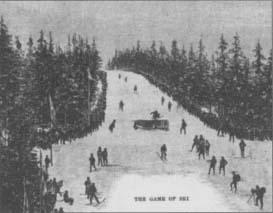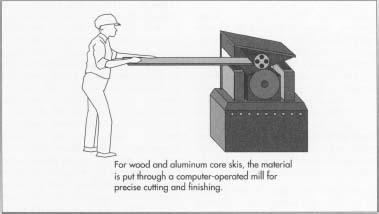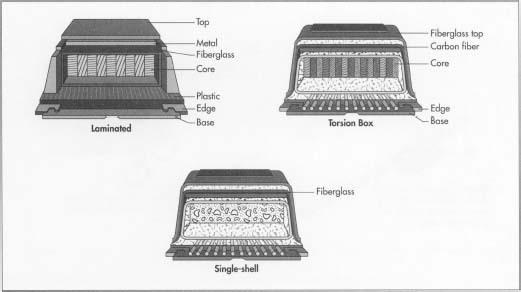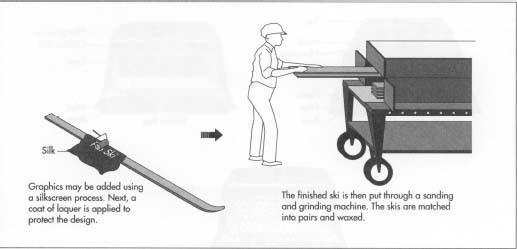Ski
Background
Although skiing is a popular sport today, the first skis were used as a quick and efficient means of transportation rather than for recreation. It is believed that skis originated in the Scandinavian nations about 5,000 years ago. Early inhabitants of Sweden, Norway, and Finland probably took the idea of the earlier snowshoe and used long femur bones from animals to make the first skis. The oldest extant pair of skis can be found in the Djugarden Museum in Stockholm, Sweden. Experts estimate the animal-bone skis are at least 4,000 years old. The early models closely resembled snowshoes, but other discovered skis—thought to be around 2,000 years old—appear similar to the ones we know today in their elongated shape and upward-curving front tip. Skis can be seen in pictographic paintings of the prehistoric era, and the first written mention of skis came around A.D. 1000 in the Norse sagas. The word "ski" is a Norwegian term for this early type of conveyance, but the Germanic and Latin root of the word means "to split"—the splitting of the bone into a pair of skis.
History
Bone skis were attached to the wearer via crude leather thongs, and early skiers proceeded without the benefit of poles. The use of skis evolved from an efficient means of winter transportation into a military tool with the Battle of Oslo in 1200, when Norwegian scouts were sent on skis to investigate the Swedish enemy camp. By the late Middle Ages skis were used regularly in battle, and soldiers were routinely issued skis or snowshoes. They were also popular with doctors, clergy, midwives, and others whose livelihood involved long treks through Scandinavian landscapes. Medieval skis were made from wood and were about 7.5 feet (2.3 m) long, 2 inches (5 cm) thick, and 5 inches (13 cm) wide. The prototype of today's ski boot was only a simple leather shoe, and it was attached to the ski itself with a leather or willow branch binding around the toes. The first heel strap was used in the 18th century by Norwegian soldiers in a ski unit, thus enabling them to ski downhill faster without losing control. They were also the first to use a pole.
Great regional differences existed in ski shape and length, with each Scandinavian village or hamlet making its own particular style, but one popular model widely used during the 19th century was the Osterdal. The Osterdal consisted of one short ski called the andor that was usually from 4-6 feet (1.2-1.8 m) in length. It was used to push off against the snow, and its bottom was sometimes covered with fur. The longer ski of the pair, reaching between 8 and 10 feet (2.4-3 m) in length, was used for gliding and was grooved on the bottom to guide it smoothly across the snow. It was also during the 19th century that skiing developed into a sport in Sweden and Norway, a change preceded by the invention of standard methods of turning and stopping. The sport's popularity eventually spread to Europe and the United States by the beginning of the 20th century. Scandinavian immigrants brought their enthusiasm for skiing to northern states such as Michigan and Minnesota as well as the western frontier. Many of these early skiers were Norwegian miners who are responsible for the first ski competitions and resorts in the U.S.
Skiing as a serious sport began in earnest around World War II. Downhill skiing had become popular in the Swiss Alps, especially after the "snowplow" method of slowing down was developed by Austrian enthusiast Mathias Zdarsky. Zdarsky also shortened the length of the still-wooden skis to 8 feet (2.4 m) and introduced a second pole for better balance in speedy downhill treks. Ski clubs sprang up in colleges around the northeastern U.S., and the sport was an integral part of the first Winter Olympics held in Chamonix, France, in 1924. Ski resorts also appeared in Vermont, New Hampshire, Colorado, California, and Idaho as well as in the Alps and Scandinavian countries. Their popularity increased even further after the development of the rope tow in 1932 and the chair lift five years later. In the decades after World War II, enthusiasm for skiing took on epic proportions and millions of enthusiasts joined in.
Despite the sport's increasing popularity, little had changed about the ski itself. Still constructed of light wood, usually hickory or ash, steel edges were introduced on the bottom to give them better glide, but a quickening depletion of inexpensive wood led to the development of skis made from more modern materials. Metal skis, especially the Dow Metal Air Ski, became common in the mid-1950s. This brand competed with the Truflex, developed by three men who worked together in the aircraft industry. These skis had no steel edges and often became stuck in wet snow because wax could not be used on their metal undersides. Aluminum was first used in skis by American skier Howard Head. The light metal was sandwiched around a wooden core and fused by glue and heat, but this aluminum underside froze easily. Head next fashioned a ski made from lightweight and flexible plastic, and added steel edges. The first pairs of Head skis were expensive but popular with part-time ski enthusiasts who found them easy to use, and within a matter of years the experts began using them as well. Meanwhile, bindings had evolved from simple leather straps to iron devises that attached the toe to the ski, leaving the heel free to move.

High in the Sierra Nevada Mountains between Placerville, California, and Carson City, Nevada, John A. Thomson, a native of Norway, delivered mail in the 1860s and 1870s. Thomson carried 100-pound packs as he made his way through the snow-covered ranges on what were referred to as "snowshoes" in those days. "Snowshoe" Thomson was a legend of the Sierras and one of the pioneers of American skiing. When he died at the age of 49 in 1876, friends erected his granite tombstone with a pair of snow skis carved on it.
Even before Thomson was drudging through the high Sierras, miners were careening down mountain slopes on "wooden wings." Tournaments were held in the Sierras as early as the 1850s with miners making bets of beer, silver dollars, and gold claims. Not long after, popular skiing competitions were being held in Alta, Utah; Aspen, Colorado; Berlin, New Hampshire; and Ishpeming, Michigan. Invented in Scandinavia and Europe, skiing was quickly and eagerly adopted by Americans in places where climate and geography lended themselves to winter sports. However, if was not until the 1890s that skiing became a true participatory sport, drawing people from all walks of life and regions of the country.
The 1930s were an era of rapid growth for the sport. Fueled by interest in the 1928 Winter Olympic Games in St. Moritz, Switzerland, American winter sports enthusiasts were exhilarated by hosting the 1932 Winter Olympics at Lake Placid, New York. Just the year before, the Boston and Main Railroad inaugurated a regular run of its ski train from urban centers to the skiing ranges of New England. In 1930 it is estimated that there were 75 ski clubs with 3,500 skiers; by 1940 there were over 2 million skiers in the United States.
William S. Pretzer
Raw Materials
In modern skis, the integral part of the unit is the inner core, which can be made from a variety of materials. When skis were constructed entirely of wood, the core's material was irrelevant. With the advent of metal, however, the core determined the strength and flexibility of the ski. Ski manufacturers and aficionados are split into two camps, one group preferring wood and the other foam as the material of choice. When using wood, manufacturing engineers must be extremely precise in matching the wood of each inner core in the pair. The weight, strength, and character of the wood must correspond precisely so that both right and left skis perform in the same manner at high speeds. Ash, beech, poplar, and okume are the most common types of wood used in skis.
Foam was first introduced as core material in the 1970s and yields a lighter ski than those with wooden cores. Foam core is more easily controlled in the manufacturing process and absorbs vibrations better than wood. It has the added advantage of being cheaper than wood. Most foam cores are made from polyurethane. A third type of material used in the core is aluminum. In skis with aluminum cores, the metal is fashioned into a honeycomb pattern. These cores are light and retain an excellent tensile strength from the aluminum, but are also more flexible than those with wood cores.
The outer part of the ski may be manufactured from a wide array of materials. Most common are fiberglass, carbon fibers, or a type of epoxy. The bottom part of the ski, the one designed for contact with the snow, is called the base. Polyethylene is the most popular material used in the bases of modern skis. One of the drawbacks of the polyethylene base is its softness, and with time the ski can become scratched by small stones and ice. A polyethylene candle is used by skiers and ski repair technicians to patch such scratches on the base. Additionally, because of its chemical nature, polyethylene is easily broken down by ultraviolet rays. This is remedied by applying a coat of wax to the skis after each use. Wax manufacturers make several different formulations of wax that are geared toward the type and temperature of the snow. The edges of skis are made of steel, which may be regular strength or hard tempered.
Design
Although a ski appears to be a rather simple piece of lightweight synthetic material, the factors involved in its design are based on complex principles of physics, engineering, and materials science. The first consideration is the weight and strength of the ski. It must be lightweight enough to glide easily across snow, yet strong enough to support the skier in the event of a sudden stop. The ski must also be waterproof and relatively resistant to damage from ice or rocks encountered at high speeds. Finally, the ski itself must have a permanent camber, or bend, to it. There are two types of camber: bottom camber refers to the arc of the ski as seen from the side, and its purpose is to evenly distribute the weight of the skier. The ski is narrower at the center in order to distribute the weight more efficiently. Side camber refers to the arc on each side of the ski as seen from above, designed to enable the skier to turn while in motion.
There are four basic types of skis. The first are downhill skis, used for speed skiing. They are longer, heavier, and wider than the other types of ski, and have less flexibility. A typical length is 87 inches (2.2 m). The binding is located towards the rear of the ski. The slalom ski is better for agility and quick turns. They are shorter and lighter than downhill skis, but are not recommended for high speeds. A common length of a slalom ski is 81 inches (2 m). The third type of ski, the giant slalom, combines the speed afforded by the downhill and the easy turns afforded by the slalom. The combination, or standard ski, is the generic model geared toward most skiers. All of the above skis are used in Alpine, or downhill skiing. Cross-country skis are called Nordic and are shorter and designed much differently.
Skis are manufactured in a variety of lengths, measured in centimeters. The length of the ski depends on the height and experience of the skier, and the type of terrain on which it will be used. For Alpine skiing, there are several different models—cruising skis, for taking long turns downhill at a high rate of speed; bump skis, designed to travel effortlessly over clumps of snow known as moguls, and powder skis, for cutting through deep snow. The categories are combined in the all-around ski, designed for use in all of the above situations.
Other factors guide ski design. The type of snow on which the ski will be used is a crucial

The design of the ski's core is also important, since the core determines the amount of vibration the skier will feel. The speed at which the ski travels downhill or across terrain results in vibrations that affect the skier. Too much vibration tires the skier out and makes it hard to control the skis. To eliminate this, ski engineers attempt to design an inner construction that absorbs as much of the vibration as possible without sacrificing the life of the ski. If all vibration was eradicated, the ski would perform poorly so a right balance must be achieved. A ski will also be grooved in one or two lines along its base. This enables it to maintain a straight line when gliding through the snow.
The Manufacturing
Process
Modern skis can be classified into three different types: laminated, torsion-box, and single-shell. The laminated method is the one most commonly used in ski manufacturing, since the combination of various materials allows for greater array of models. Laminated skis may contain one or all of the following materials: plastic, fiberglass, carbon, wood, steel, aluminum, neoprene, or ceramics. These elements are sandwiched or layered on the top and bottom of the core. In a torsion-box ski, the core material is surrounded by fiberglass or carbon fibers. Instead of being sandwiched around the core, the layers wrap around it in what is known as "wet wrap construction." The core is then sealed with resin and heat. This more complex manufacturing process means that torsion-box skis are more expensive than laminated ones, but they provide better handling and thus are more appealing to serious skiers. Single-shell skis are made from a strong inner material such as wood, but enclosed by a flexible fiberglass or plastic shell and sides. The lighter weight of single-shell skis means that more control is located at the tip of the skis, giving the user better steering control and turning ability.
Milling the core
-
1 The manufacturing process for most skis originates in a warehouse-type
room of the factory. Here, all the raw materials—the roughly-cut
blocks of wood for wood cores, the steel edges, sheets of polyethylene
for the bases, rolls of fiberglass or aluminum—are sorted and
stacked. For skis with wood cores, the pre-laminated wood is
put through a mill for precise cutting and finishing. These mills are computer-operated by a technician who sets the parameters through numerical controls on the machine. This process is also used for aluminum cores. The machine cuts and mills the material, including the core's thickness and side-cut, and also collects the excess, which are returned to the suppliers. In skis with polyurethane cores, the top and base layers are put into a mold, then a press, and the foam is injected with a hose. As it expands and hardens, the foam fuses the layers and becomes the core.
 Modern skis can be classified into three different types. In laminated skis, various layers sandwich the core on top and bottom. In torsion-box ski construction, the layers wrap around the core. In single-shell construction, polyurethane foam is sometimes injected into the ski shell. As this foam expands and hardens, the top and sides form one sheet.
Modern skis can be classified into three different types. In laminated skis, various layers sandwich the core on top and bottom. In torsion-box ski construction, the layers wrap around the core. In single-shell construction, polyurethane foam is sometimes injected into the ski shell. As this foam expands and hardens, the top and sides form one sheet.
Assembling the layers
- 2 In the next step, the core and the rest of the layers, including the top and base, are placed into a mold and then into a press. Heat and pressure result in a rudimentary ski, then epoxy resin is used to completely seal the layers together. Single-shell, or "cap" skis, require a more complicated assembly process and more precise molding chambers. They still use wood or foam cores, but the top and sides are united in one sheet and this makes the core less integral to the ski's overall performance.
Bonding the base and edges
- 3 The polyethylene base, the running surface of the ski, is bonded onto the ski. Steel edges are also bonded onto the ski surface.
Applying graphics
-
4 Another important difference between the laminated and torsion-box
types of skis and single-shell ones is the application of graphics.
Flashy colors and logos are a trademark of ski design, and manufacturers
use graphics to differentiate their models. In single-shell skis,
graphics are applied to the top, or cap, before the parts go into the
mold. The heat-transfer process is commonly used, a method that can best
be compared to the way an emblem is applied to a
t-shirt
with an iron. In the ski industry, this process is called sublimation,
and it yields a visually complex but clear image. Another method used in
single-shell graphics applications is backprinting, in which graphics
are applied in reverse to a clear sheet through silk-screening, then
flipped over. During assembly, the freshly applied graphics remain
protected during the molding stage.

With traditional laminated and torsion-box skis, the graphics are applied in one of the final steps of the manufacturing process. The actual ski goes through a silkscreen process, where the design is first put on a piece of silk or other thin fabric. The areas which are not to be colored are covered with an impermeable substance, and then ink is forced through the fabric. This must be done several times over, one press for each color, and the ski must be allowed to dry between presses. A curtain coat of lacquer is then applied. Because of the complexities of this process, skis made this way often take days, to dry, whereas single-shell skis can be finished in a matter of hours.
Finishing
- 5 The final finishing process is nearly the same among all types of skis. The bases must be put through a machine that grinds and polishes them, and this is done with a combination of belt sanding and stone grinding. Stone grinding is considered superior to the belt method. Next, the skis must be matched up into pairs. The edges are also beveled and polished. This is done with a machine that tests their flexibility and camber. After they are paired, a quality control technician makes certain that they are well-matched. In the final stages, the steel edges are oiled, the skis waxed, wrapped in polyethylene, and boxed for shipping to retail outlets.
Quality Control
Although ski factories employ technicians who check the skis during each stage of the manufacturing process, much of the testing is done after the skis arrive in stores. It often takes some time for all the synthetic materials to set properly, and the surface of the ski may change during shipping. This process by which skis are readied for the slopes is called tuning, and is performed by a ski technician, or "tuner," employed in retail ski outlets or pro shops. The tuner uses files to make the base of the ski as flat as possible. The steel edges are further beveled, because the base of the ski will shrink when it hits the snow. The tips and tails are again sanded and waxed for protection and better glide.
The Future
Experts predict that ski manufacturing will become more and more geared toward the production of the single-shell ski. Its more cost-efficient methods and improved performance are the primary reasons for this forecast—single-shells are lighter and handle vibration more effectively. Although retooling factories is expensive, the single-shell manufacturing process takes only a few hours—compared to days for laminated and torsion-box construction—and requires less workers. In time, these factors will reduce the cost of the ski. Environmental concerns are also reduced by single-shell production. Ski factories both in the United States and in Europe must adhere to increasingly stringent government regulations in regard to the exposure of workers to chemicals and noise, as well as the reduction of waste during the manufacturing process. In the manufacture of single-shell skis, these elements are greatly diminished. In all types of ski factories, new mills and assembly machines now collect excess materials for return to suppliers, and modern grinding machines are quieter and safer. Robotics technology is also increasingly used in the manufacturing process.
Where To Learn More
Books
Masia, Seth. The Ski Maintenance and Repair Handbook. Contemporary Books, 1982.
Ski Magazine's Encyclopedia of Skiing. Harper & Row, 1978.
Sports Illustrated Skiing. Time/Harper & Row, 1985.
Periodicals
Chalsma, Jennifer K. and Kenneth J. Korane. "Engineering the Ultimate Ski." Machine Design, February 7, 1991, pp. 26-32.
Grout, Dill. "Capped Crusaders." Skiing, October 1993, pp. 138-44.
— Carol Brennan
Comment about this article, ask questions, or add new information about this topic: